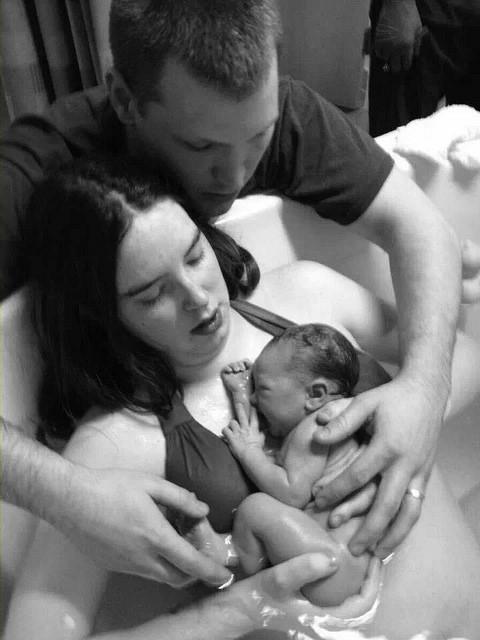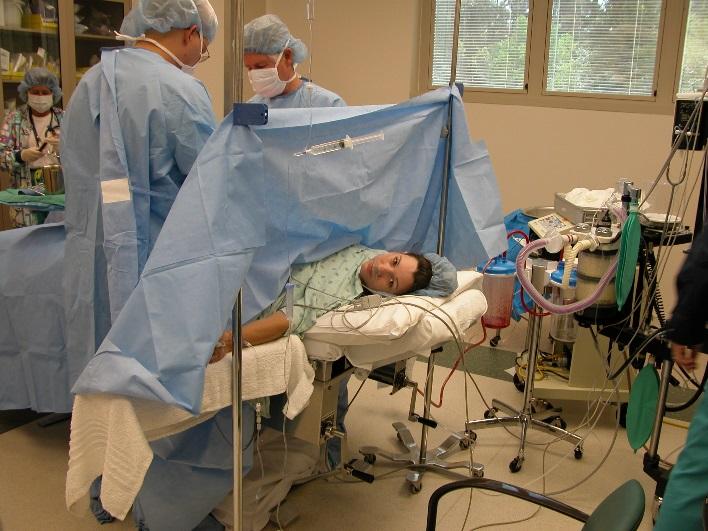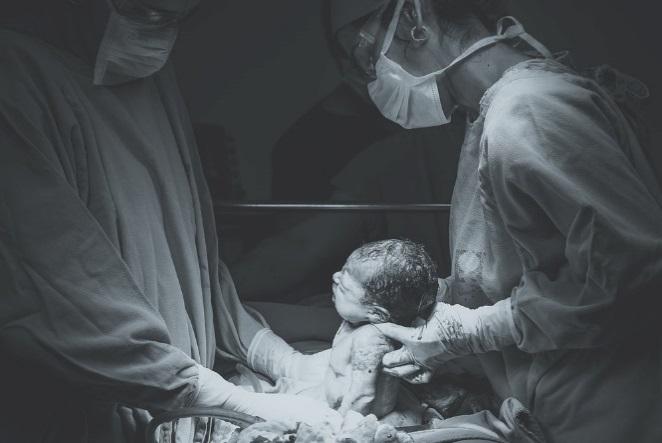4.3 Approaches to Childbirth
The birthing experience is influenced by many aspects of society. Practices such as who is present for the birth, what medical or holistic approaches are used to aid in the delivery, what steps expecting parents follow to prepare for parenthood may be shaped by the social context of which the family is a part.
4.3.1 The Settings for Labor and Delivery
People can give birth in a variety of settings, depending on their preferences, medical needs, and availability of resources. Some of the most common settings for giving birth include: hospitals, birth centers, maternity clinics and home births.
Hospitals are the most common place for childbirth in many countries. They provide access to medical interventions and emergency care if needed. Hospitals may have different options for labor and delivery, such as water births, epidurals, and cesarean sections.
Birth centers are facilities designed specifically for childbirth. They are typically run by midwives and offer a more home-like environment than hospitals. Birth centers may offer options for natural childbirth, such as water births, and may have fewer medical interventions available than hospitals.
In some countries, maternity clinics provide prenatal care and childbirth services. They may be run by midwives or obstetricians and may be located within a hospital or in the community.
Home births involve giving birth at home, typically with the assistance of a midwife or other trained professional. Home births can offer a more comfortable, familiar environment for some people, but may not be suitable for those with high-risk pregnancies.
Ultimately, the choice of setting for giving birth is a personal decision that should be based on individual needs and preferences, as well as consultation with healthcare providers.
4.3.1.1 Doulas and Midwives
A midwife is a healthcare professional who provides care to women during pregnancy, childbirth, and the postpartum period. Midwives are trained to provide a range of services, from routine prenatal care to assisting with labor and delivery. Midwives may work in hospitals, birth centers, or attend home births.
Midwives may provide a more holistic approach to care, focusing on the physical, emotional, and social needs of their clients. They may also provide education and support for breastfeeding, newborn care, and contraception. Midwives may work collaboratively with other healthcare providers, such as obstetricians, to provide comprehensive care to their clients. Midwives may be trained in different ways depending on their location and the type of care they provide. Some midwives are trained nurses who have specialized in midwifery, while others may have completed a midwifery education program. In some countries, midwives are the primary providers of maternity care, while in others they work alongside obstetricians and other healthcare providers.
A birth doula is a trained professional who provides emotional, physical, and informational support to a woman and her partner during pregnancy, childbirth, and the immediate postpartum period. The word “doula” comes from ancient Greek and means “a woman who serves.” Birth doulas do not provide medical care, but they can offer a variety of non-medical techniques to help a woman cope with labor, such as breathing exercises, massage, position changes, and relaxation techniques. They also provide continuous emotional support, helping to reduce anxiety and stress during labor and birth. In addition, birth doulas can help a woman and her partner understand the choices and options available to them during labor and birth, and can advocate for their preferences with healthcare providers. Research has shown that women who receive support from a birth doula are more likely to have a positive childbirth experience, have shorter labors, and are less likely to need interventions like pain medication or a cesarean section (Bohren et al., 2017).
4.3.2 Methods of Labor and Delivery
4.3.2.1 Unmedicated Delivery
An unmedicated delivery, commonly referred to as natural delivery, is the process of giving birth without the use of pain medication or other medical interventions. Unmedicated delivery is considered a safe and healthy option for many women who are low-risk and have a low-risk pregnancy. During natural delivery, the mother uses breathing techniques, relaxation, and other coping mechanisms to manage pain and discomfort during labor. Women who choose to deliver without medications may also opt for alternative therapies such as acupuncture, massage, or water birth to help them manage pain and discomfort.
Unmedicated delivery can have many benefits for both mother and baby. For example, it can reduce the risk of complications associated with medical interventions such as epidurals or induction, and can promote bonding between mother and baby. For many mothers, a critical element of having a successful delivery without the aid of medication is a social support system, including involved partners, family members and kin networks to help coach and encourage a woman through labor and delivery. In many cultures, labor and delivery is not limited to the parents-to-be. In fact, it is common in many places around the world for women to lead and encourage one another through this process. However, there are also associated risks and complications, including prolonged labor, perineal tears, and hemorrhage. It is important for women to discuss their options for delivery with their healthcare provider and to make an informed decision based on their individual circumstances and preferences.

Figure 4.4. Unmedicated childbirth.
The term “natural delivery” is more commonly used to describe an unmedicated delivery. However, it creates some issues with supporting an inclusive culture of labor and delivery. We introduce the term in this chapter because it is standard terminology, and therefore important to have an accurate understanding of its meaning. It is equally important to call out when language that is frequently used (referred to as normative) overlooks or devalues another’s equally important experience, however unintentional. By referring to one way of delivering a child as “natural,” the implication is that other ways of delivering are somehow not natural, or less than. The idea of a drug-free delivery may be held in a higher regard, an aspiration to reach for as an indicator of the qualities of an expecting mother as both the kind of woman she is and the kind of mother she will be. Some women have even reported feeling shame or embarrassment that they were unable to deliver with the aid of medication (e.g., Happel-Parkins & Azim, 2016) . There are many factors contributing to how a woman progresses through labor, only some of which are about personal choices. Therefore, it is important to remember that every labor and delivery is a unique story, and each woman must navigate through the experience able to focus on her own vision of what defines a successful delivery.
4.3.2.2 C-Section delivery
A c-section, or cesarean section, is a surgical procedure in which a baby is delivered through an incision made in the mother’s abdomen and uterus. A cesarean procedure is typically performed when a vaginal birth is not possible or would be unsafe for either the mother or the baby. Some of the common reasons for a c-section include:
- The baby is in a breech position (feet first) or in another abnormal position that would make vaginal delivery difficult or dangerous.
- The mother has a health condition that makes vaginal delivery risky, such as high blood pressure or heart disease.
- The mother has had a previous c-section and vaginal delivery is not recommended due to the risk of uterine rupture.
- The baby is too large to be safely delivered vaginally.
- Labor is not progressing normally or there are concerns about the baby’s health during labor.
A c-section is performed under anesthesia, and the incision is typically made horizontally just above the pubic hairline. The baby is then delivered through the incision and the uterus and incision are closed with stitches. Recovery from a c-section typically takes longer than recovery from a vaginal birth, but the procedure can be life-saving in certain situations. Later in this chapter we discuss postnatal care and include information on how postnatal needs differ when recovering from a cesarean delivery.
The United States has one of the highest rates of c-sections in the world, with approximately one in three births being delivered by c-section (Osterman et al., 2023). There are several factors that contribute to this high rate:
- Medicalization of childbirth: In the U.S., childbirth is often treated as a medical event that requires medical intervention. Obstetricians may be more likely to recommend a c-section to avoid potential complications, even if a vaginal birth may be possible.
- Defensive medicine: In some cases, obstetricians may be concerned about the possibility of a lawsuit if a vaginal birth leads to complications for the mother or baby. As a result, they may be more likely to recommend a c-section as a way to minimize the risk of complications and potential legal liability.
- Maternal age and health: The U.S. has a higher rate of older mothers and mothers with pre-existing health conditions, both of which can increase the likelihood of a c-section.
- Elective c-sections: Some women may choose to have a c-section for personal or scheduling reasons, such as wanting to have a planned delivery date or avoiding the pain of labor.
- Fertility treatments result in multiple fetuses: Treatment for fertility issues frequently results in pregnancies with multiple fetuses, dramatically increasing the likelihood of a c-section in order to optimize health of mother and babies.
- Risks with a VBAC delivery: Once a mother has given birth through c-section, a vaginal birth is considered risky. Therefore, the vaginal birth after cesarean, or VBAC, is not an option for every woman. Higher first-birth instances of c-section will lead to greater numbers of overall c-sections because of concerns regarding VBACs.
- Lack of access to midwifery care: Midwives are often trained to support natural childbirth and can help reduce the likelihood of unnecessary interventions like c-sections. However, many women in the U.S. do not have access to midwifery care, which can contribute to higher rates of c-sections.
C-sections are generally safe for both the mother and baby, but they do involve some risks and a longer recovery time compared to vaginal delivery. The decision to have a c-section should be made in consultation with a healthcare provider and based on individual medical circumstances.

Figure 4.5. A woman receiving a C-section.

Figure 4.6. A baby being delivered by C-section.
4.3.2.3 Other Medical Interventions in Childbirth
There are various medical interventions that may be used during childbirth to ensure the safety and well-being of both the mother and the baby. Some of these interventions may be necessary due to medical complications or risks, while others may be used to manage pain or expedite delivery.
Induction of labor: Induced labor is the process of starting labor artificially using medications or other methods. This is typically done when there are concerns about the health of the mother or baby, or if the pregnancy has gone past the due date and there are no signs of spontaneous labor. Induction may also be recommended if the mother has certain medical conditions, such as high blood pressure or gestational diabetes (Cheng, et al, 2017). The most common method of inducing labor is by administering medications such as prostaglandins or oxytocin. Prostaglandins are hormones that can help to ripen the cervix, which is the opening of the uterus, making it easier for the baby to pass through. Oxytocin is a hormone that causes contractions of the uterus, which can help to initiate labor. Other methods of inducing labor include stripping the membranes, which involves separating the amniotic sac from the cervix to stimulate contractions, or rupturing the amniotic sac, which can help to release hormones that trigger labor.
Epidural anesthesia: This is a type of pain relief medication that is administered through a catheter placed into the space surrounding the spinal cord. It can provide effective pain relief during labor and delivery.
Forceps or vacuum delivery: Sometimes labor may take longer than expected, which can increase the risk of complications such as infection, fetal distress, or the need for interventions such as forceps or vacuum extraction. These are instruments that may be used to assist in the delivery of the baby, particularly if there is a risk of complications or if the mother is too exhausted to push effectively.
Fetal monitoring: Fetal monitoring is the process of using electronic devices to track the baby’s heartbeat and the mother’s contractions during labor. The purpose of fetal monitoring is to detect any signs of distress or changes in the baby’s heart rate that may indicate potential complications. There are two types of fetal monitoring:
- External monitoring involves placing two belts around the mother’s abdomen to measure the frequency and strength of contractions, as well as the baby’s heart rate. The belts are connected to a machine that records the information and allows healthcare providers to monitor the baby’s well-being during labor.
- Internal fetal monitoring: This involves inserting a small electrode through the cervix and into the baby’s scalp to directly measure the baby’s heart rate. This method provides more accurate and continuous monitoring of the baby’s heart rate than external monitoring.
Fetal monitoring is an important tool for healthcare providers during labor and delivery. It can help detect potential problems such as fetal distress, which may require intervention to ensure the safety of the mother and baby. If any signs of distress are detected, healthcare providers may recommend interventions such as changing the mother’s position, administering oxygen to the mother, or even delivering the baby via cesarean section.
Breaking the water, also known as amniotomy, is a medical procedure that involves rupturing the amniotic sac that surrounds the baby during pregnancy. This procedure is usually performed during labor to help speed up the delivery process or to induce labor.
Breaking the water can be done in a few different ways, depending on the healthcare provider’s preference and the mother’s individual circumstances. It is typically done using a special tool called an amnihook, which is a thin, plastic rod with a hook on the end that is used to puncture the amniotic sac. Some reasons why a healthcare provider may recommend breaking the water include:
- To speed up labor: If the mother’s cervix has already begun to dilate, breaking the water can help to speed up the labor process by increasing the strength and frequency of contractions.
- To induce labor: If the mother’s cervix has not yet begun to dilate, breaking the water can help to stimulate contractions and induce labor.
- To monitor the baby: Breaking the water can help to collect amniotic fluid for testing or to better monitor the baby’s condition during labor.
Breaking the water can have both benefits and risks. Some of the potential benefits include a shorter labor, a reduced need for medication to induce labor, and a decreased risk of certain complications. However, there are also some potential risks, such as infection, prolapsed umbilical cord, and an increased risk of needing a cesarean section.
4.3.2.4 Rates and Data
As of 2021, the birth rate in the United States is approximately 11.5 births per 1,000 people, according to the US Centers for Disease Control and Prevention (CDC; Osterman et al., 2023). This represents a continued decline in the birth rate, which has been steadily decreasing over the past several years. There are many factors that can impact the birth rate in the United States. Some of the most important include:
- Economic conditions: The state of the economy can have a significant impact on birth rates. During times of economic uncertainty or recession, people may delay having children or have fewer children because of financial concerns.
- Cultural and social norms: Cultural and social norms can also influence birth rates. For example, in some cultures, having a large family is valued and expected, while in others, having fewer children or delaying childbearing is more common.
- Access to contraception and family planning: Access to contraception and family planning services can also impact birth rates. When individuals have easy access to effective contraception, they may choose to delay childbearing or have fewer children.
- Education and career opportunities for women: As women have gained greater access to education and career opportunities, many have chosen to delay childbearing or have fewer children in order to focus on their careers.
- Immigration: Immigration can also impact birth rates in the United States. For example, immigrants may have higher birth rates than native-born Americans, which can contribute to an overall increase in the birth rate.
- Health and fertility trends: Advances in medical technology and changes in fertility trends, such as delayed childbearing and increased use of assisted reproductive technologies, can also impact the birth rate.
These are just some of the factors that can influence birth rates in the United States. The interplay of these factors can be complex and can vary depending on a variety of social, economic, and cultural factors. For more information on the current trends in birth rates in the United States, you can view data from the Center for Disease Control National Center for Health Statistics.
4.3.3 Licenses and Attributions for Approaches to Childbirth
“Stages of Childbirth” and “Approaches to Childbirth” by Terese Jones, Christina Belli, and Esmeralda Janeth Julyan is licensed under CC BY 4.0.
Figure 4.1. “Stages of Childbirth” by OpenStax is licensed under CC BY 3.0 / A derivative from the original work.
Figure 4.2. “Stages of Childbirth” by OpenStax is licensed under CC BY 3.0 / A derivative from the original work.
Figure 4.3. “Stages of Childbirth” by OpenStax is licensed under CC BY 3.0 / A derivative from the original work.
Figure 4.4. “Baby Family Photo” by U.S. Army Alaska is licensed under CC BY 2.0.
Figure 4.5. Image by Tammra M is licensed under CC BY 2.0
Figure 4.6. “Greyscale Photo of Medical Operation” by Patricia Prudente on Unsplash.
